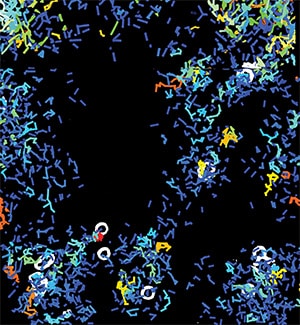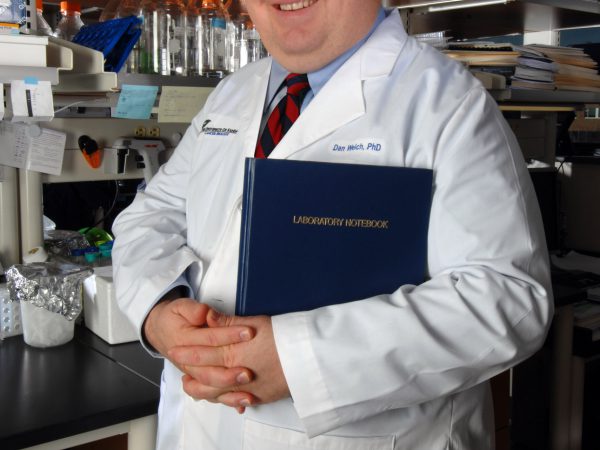Editors’ Picks, July 2024: Risks of CAR T-cell Therapy, Sarcoma Advances, and More
Whether you’re sitting under the shade of a beach umbrella or enjoying the climate-controlled indoors, catch up on some of the latest advances in cancer research with this month’s Editors’ Picks from the 10 American Association for Cancer Research (AACR) journals. July’s picks include treating cancer by upregulating the very pathways that drive them, results from clinical trials for soft-tissue sarcoma and euthyroid patients undergoing laryngectomy, a look at the evolution of Ewing sarcoma metastasis, and a review of mechanisms underlying secondary cancers after CAR T-cell therapy, among others.
The abstracts of these articles are included below, and the full text of each article is freely available through the provided links.
Journal: Blood Cancer Discovery
The Fate(s) of CAR T-Cell Therapy: Navigating the Risks of CAR+ T-Cell Malignancy
The introduction of chimeric antigen receptor (CAR) T-cell therapy represents a landmark advancement in treating resistant forms of cancer such as leukemia, lymphoma, and myeloma. However, concerns about long-term safety have emerged following an FDA investigation into reports of second primary malignancies (SPM) after CAR-T cell treatment. This review offers a thorough examination of how genetically modified T cells might transform into CAR+ SPM. It explores genetic and molecular pathways leading to T-cell lymphomagenesis, the balance between CAR T-cell persistence, stemness, and oncogenic risk, and the trade-off of T-cell exhaustion, which may limit therapy efficacy but potentially reduce lymphomagenesis risk.
Significance: An FDA probe into 22 cases of second primary T-cell malignancies following CAR T-cell therapy stresses the need to investigate their origins. Few may arise from preexisting genetic and epigenetic alterations and those introduced during therapeutic engineering. Technological advances, regulatory oversight, and patient monitoring are essential to mitigate potential risks.
This review was one of several articles on this topic featured on the cover of the July issue.

Journal: Cancer Discovery
Paradoxical Activation of Oncogenic Signaling as a Cancer Treatment Strategy
Cancer homeostasis depends on a balance between activated oncogenic pathways driving tumorigenesis and engagement of stress response programs that counteract the inherent toxicity of such aberrant signaling. Although inhibition of oncogenic signaling pathways has been explored extensively, there is increasing evidence that overactivation of the same pathways can also disrupt cancer homeostasis and cause lethality. We show here that inhibition of protein phosphatase 2A (PP2A) hyperactivates multiple oncogenic pathways and engages stress responses in colon cancer cells. Genetic and compound screens identify combined inhibition of PP2A and WEE1 as synergistic in multiple cancer models by collapsing DNA replication and triggering premature mitosis followed by cell death. This combination also suppressed the growth of patient-derived tumors in vivo. Remarkably, acquired resistance to this drug combination suppressed the ability of colon cancer cells to form tumors in vivo. Our data suggest that paradoxical activation of oncogenic signaling can result in tumor-suppressive resistance.
Significance: A therapy consisting of deliberate hyperactivation of oncogenic signaling combined with perturbation of the stress responses that result from this is very effective in animal models of colon cancer. Resistance to this therapy is associated with loss of oncogenic signaling and reduced oncogenic capacity, indicative of tumor-suppressive drug resistance.
This article was featured on the cover of the July issue.
Journal: Cancer Epidemiology, Biomarkers & Prevention

Background: Screening with anti-Epstein–Barr virus (EBV) serology and endoscopy decreased nasopharyngeal carcinoma (NPC) mortality in Guangdong in a randomized trial. We conducted a secondary analysis of this trial using local incidence and cost data to optimize screening programs, hypothesizing that screening could be cost-effective in southern China.
Methods: Screening costs and life-years after NPC diagnosis were obtained from the Guangdong trial’s intent-to-screen population (men and women aged 30–69). Seropositive subjects were rescreened annually for 5 years. Thereafter, we evaluated 12 screening strategies in Guangdong and Guangxi using a validated model. Strategies used combinations of serology, nasopharyngeal swab PCR (NP PCR), endoscopy, and MRI from trial subcohorts. Incidence data and costs were obtained from local cancer registries and the provincial healthcare system.
Results: In the intent-to-screen population, screening with serology and endoscopy was cost-effective (¥42,366/life-year, 0.52 GDP per capita). Screening for 5 to 15 years between ages 35 and 59 years met a willingness-to-pay threshold of 1.5 GDP/quality-adjusted life-years in all modeled populations. Despite doubling costs, adding MRI could be cost-effective via improved sensitivity. NP PCR triage reduced endoscopy/MRI referrals by 37%. One-lifetime screen could reduce NPC mortality by approximately 20%.
Conclusions: EBV–based serologic screening for NPC is likely to be cost-effective in southern China. Among seropositive subjects, the preferred strategies use endoscopy alone or selective endoscopy triaged by MRI with or without NP PCR. These data may aid the design of screening programs in this region.
Impact: These findings support population-based screening in southern China by defining the target population, cost-effectiveness, and optimized screening approach.
This article was featured on the cover of the July issue.
Journal: Cancer Immunology Research
IL3-Driven T Cell–Basophil Crosstalk Enhances Antitumor Immunity
Cytotoxic T lymphocytes (CTL) are pivotal in combating cancer, yet their efficacy is often hindered by the immunosuppressive tumor microenvironment, resulting in CTL exhaustion. This study investigates the role of interleukin-3 (IL3) in orchestrating antitumor immunity through CTL modulation. We found that intratumoral CTLs exhibited a progressive decline in IL3 production, which was correlated with impaired cytotoxic function. Augmenting IL3 supplementation, through intraperitoneal administration of recombinant IL3, IL3-expressing tumor cells, or IL3-engineered CD8+ T cells, conferred protection against tumor progression, concomitant with increased CTL activity. CTLs were critical for this therapeutic efficacy as IL3 demonstrated no impact on tumor growth in Rag1 knockout mice or following CD8+ T-cell depletion. Rather than acting directly, CTL-derived IL3 exerted its influence on basophils, concomitantly amplifying antitumor immunity within CTLs. Introducing IL3-activated basophils retarded tumor progression, whereas basophil depletion diminished the effectiveness of IL3 supplementation. Furthermore, IL3 prompted basophils to produce IL4, which subsequently elevated CTL IFNγ production and viability. Further, the importance of basophil-derived IL4 was evident from the absence of benefits of IL3 supplementation in IL4 knockout tumor-bearing mice. Overall, this research has unveiled a role for IL3-mediated CTL–basophil cross-talk in regulating antitumor immunity and suggests harnessing IL3 sustenance as a promising approach for optimizing and enhancing cancer immunotherapy.
A related commentary was published in the July issue.
Journal: Cancer Prevention Research
Patient navigation (PN) has been shown to improve participation in cancer screening, including colorectal cancer screening, and is now a recommended practice by the Community Preventive Services Task Force. Despite the effectiveness of PN programs, little is known about the number of contacts needed to successfully reach patients or about the demographic and healthcare utilization factors associated with reach. PRECISE was an individual randomized study of PN versus usual care conducted as a partnership between two large health systems in the Pacific Northwest. The navigation program was a six–topic area telephonic program designed to support patients with an abnormal fecal test result to obtain a follow-up colonoscopy. We report the number of contact attempts needed to successfully reach navigated patients. We used logistic regression to report the demographic and healthcare utilization characteristics associated with patients allocated to PN who were successfully reached. We identified 1,200 patients with an abnormal fecal immunochemical test result, of whom 970 were randomized into the study (45.7% were female, 17.5% were Spanish-speaking, and the mean age was 60.8 years). Of the 479 patients allocated to the PN intervention, 382 (79.7%) were reached within 18 call attempts, and nearly all (n = 356; 93.2%) were reached within six contact attempts. Patient characteristics associated with reach were race, county of residence, and body mass index. Our findings can guide future efforts to optimize the reach of PN programs.
Prevention Relevance: The findings from this large study can inform clinic-level implementation of future PN programs in Federally Qualified Health Centers to improve the reach of patients needing cancer screenings, optimize staff resources, and ultimately increase cancer screenings.
Journal: Cancer Research (July 1 issue)
Extranodal NK/T-cell lymphoma (ENKTCL) is an Epstein–Barr virus (EBV)–related neoplasm with male dominance and a poor prognosis. A better understanding of the genetic alterations and their functional roles in ENKTCL could help improve patient stratification and treatments. In this study, we performed a comprehensive genetic analysis of 178 ENKTCL cases to delineate the landscape of mutations, copy number alterations (CNA), and structural variations, identifying 34 driver genes including six previously unappreciated ones, namely, HLA-B, HLA-C, ROBO1, CD58, POT1, and MAP2K1. Among them, CD274 (24%) was the most frequently altered, followed by TP53 (20%), CDKN2A (19%), ARID1A (15%), HLA-A (15%), BCOR (14%), and MSN (14%). Chromosome X losses were the most common arm-level CNAs in females (∼40%), and alterations of four X-linked driver genes (MSN, BCOR, DDX3X, and KDM6A) were more frequent in males and females harboring chromosome X losses. Among X-linked drivers, MSN was the most recurrently altered, and its expression was lost in approximately one-third of cases using immunohistochemical analysis. Functional studies of human cell lines showed that MSN disruption promoted cell proliferation and NF-κB activation. Moreover, MSN inactivation increased sensitivity to NF-κB inhibition in vitro and in vivo. In addition, recurrent deletions were observed at the origin of replication in the EBV genome (6%). Finally, by integrating the 34 drivers and 19 significant arm-level CNAs, nonnegative matrix factorization and consensus clustering identified two molecular groups with different genetic features and prognoses irrespective of clinical prognostic factors. Together, these findings could help improve diagnostic and therapeutic strategies in ENKTCL.
Significance: Integrative genetic analyses and functional studies in extranodal NK/T-cell lymphoma identify frequent disruptions of X-linked drivers, reveal prognostic molecular subgroups, and uncover recurrent MSN alterations that confer sensitivity to NF-κB inhibition.
Journal: Cancer Research (July 15 issue)
Metabolic reprogramming is a hallmark of cancer and is crucial for cancer progression, making it an attractive therapeutic target. Understanding the role of metabolic reprogramming in cancer initiation could help identify prevention strategies. To address this, we investigated metabolism during acinar-to-ductal metaplasia (ADM), the first step of pancreatic carcinogenesis. Glycolytic markers were elevated in ADM lesions compared with normal tissue from human samples. Comprehensive metabolic assessment in three mouse models with pancreas-specific activation of KRAS, PI3K, or MEK1 using Seahorse measurements, nuclear magnetic resonance metabolome analysis, mass spectrometry, isotope tracing, and RNA sequencing analysis revealed a switch from oxidative phosphorylation to glycolysis in ADM. Blocking the metabolic switch attenuated ADM formation. Furthermore, mitochondrial metabolism was required for de novo synthesis of serine and glutathione (GSH) but not for ATP production. MYC mediated the increase in GSH intermediates in ADM, and inhibition of GSH synthesis suppressed ADM development. This study thus identifies metabolic changes and vulnerabilities in the early stages of pancreatic carcinogenesis.
Significance: Metabolic reprogramming from oxidative phosphorylation to glycolysis mediated by MYC plays a crucial role in the development of pancreatic cancer, revealing a mechanism driving tumorigenesis and potential therapeutic targets.
A related commentary was published in the July 15th issue.
Journal: Clinical Cancer Research (July 1 issue)
Purpose: While cytotoxic chemotherapy is the standard first-line treatment for patients with metastatic soft-tissue sarcoma (STS), clinical outcomes remain suboptimal. Our prior study showed lurbinectedin plus doxorubicin is well tolerated with promising clinical activity in STS. We designed this phase 1b trial to optimize dosing as the basis for a randomized trial in leiomyosarcoma and to further explore the safety profile and efficacy signal.
Patients and Methods: Patients had advanced/metastatic STS and no prior anthracycline/lurbinectedin/trabectedin. Escalation followed a 3 + 3 design with 3-week cycles: lurbinectedin (3.2 mg/m2 day 1) and two doxorubicin levels (DL1, 25 mg/m2 day 1; DL2, 25 mg/m2 days 1 and 8). The primary objectives were to identify the maximum tolerated dose and recommended dose for subsequent randomized trials.
Results: Ten patients were enrolled in a 6-month period. The most common treatment-emergent adverse events were grade (G) 2 fatigue and nausea, and G2 cytopenias with no febrile neutropenia events. There were two dose-limiting toxicities (DLTs) at DL2 [day 8 (G2 alanine aminotransferase [ALT]/aspartate aminotransferase increase, G3 neutropenia)], and one DLT in DL1 (G3 ALT increase). These were reversible and all patients continued the study. DL1 was chosen for further study. At the time of data cutoff, the estimated median progression-free survival is 16.5 months [95% confidence interval (CI), 6.0–ND]. The objective response rate was 60% (6/10 confirmed partial responses).
Conclusions: In this phase 1b study, the recommended dose is lurbinectedin 3.2 mg/m2 in combination with doxorubicin 25 mg/m2 every 3 weeks. The study combination was well tolerated and demonstrated intriguing clinical activity.
July is Sarcoma Awareness Month. Read about recent advances in treating sarcomas in a recent blog article.
Journal: Clinical Cancer Research (July 15 issue)
Purpose: Patients undergoing head and neck cancer surgery after prior radiation or chemoradiation are at high risk for wound complications. Hypothyroidism is a known risk factor for wound complications, especially fistulae after salvage total laryngectomy. The purpose of this phase II clinical trial is to investigate the effect of perioperative intravenous levothyroxine supplementation on wound complications in patients undergoing salvage total laryngectomy.
Patients and Methods: Euthyroid patients previously treated with radiation/chemoradiation undergoing total laryngectomy were prospectively recruited (n = 72). Postoperatively, intravenous levothyroxine was administered at a weight-based dose (1.3 mcg/kg/d) and transitioned to enteral dosing on day 7. Free T3, T4, and thyroid-stimulating hormones were collected, and dosing was adjusted accordingly. The primary endpoints were rates of fistula formation and fistula requiring reoperation, compared with matched historic controls. All patients were monitored for adverse effects.
Results: The rate of postoperative hypothyroidism was 21% compared with 49% in a matched historic cohort. The rate of fistula formation was 18.1%, whereas the rate of fistula requiring reoperation was 4.2%, significantly lower than rates in our historic cohort (34.6% and 14.8%, respectively; P = 0.02 and 0.01). Postoperative hypothyroidism and recurrent clinical stage predicted fistula requiring reoperation in multivariate analysis; other acute phase reactants were not predictive. There were no observed adverse events related to levothyroxine supplementation.
Conclusions: Postoperative intravenous levothyroxine supplementation reduced rates of acute hypothyroidism, fistula formation, and fistula requiring reoperation in patients undergoing salvage total laryngectomy without adverse effects. Intravenous levothyroxine is a viable strategy to reduce wound complications in this high-risk patient population.
Journal: Molecular Cancer Research
The mechanistic basis for the metastasis of Ewing sarcomas remains poorly understood, as these tumors harbor few mutations beyond the chromosomal translocation that initiates the disease. Instead, the epigenome of Ewing sarcoma cells reflects the regulatory state of genes associated with the DNA-binding activity of the fusion oncoproteins EWSR1::FLI1 or EWSR1::ERG. In this study, we examined the EWSR1::FLI1/ERG’s repression of transcription factor genes, concentrating on those that exhibit a broader range of expression in tumors than in Ewing sarcoma cell lines. Focusing on one of these target genes, ETS1, we detected EWSR1::FLI1 binding and an H3K27me3-repressive mark at this locus. Depletion of EWSR1::FLI1 results in ETS1’s binding of promoter regions, substantially altering the transcriptome of Ewing sarcoma cells, including the upregulation of the gene encoding TENSIN3 (TNS3), a focal adhesion protein. Ewing sarcoma cell lines expressing ETS1 (CRISPRa) exhibited increased TNS3 expression and enhanced movement compared with control cells. Visualization of control Ewing sarcoma cells showed a distributed vinculin signal and a network-like organization of F-actin; in contrast, ETS1-activated Ewing sarcoma cells showed an accumulation of vinculin and F-actin toward the plasma membrane. Interestingly, the phenotype of ETS1-activated Ewing sarcoma cell lines depleted of TNS3 resembled the phenotype of the control cells. Critically, these findings have clinical relevance as TNS3 expression in Ewing sarcoma tumors positively correlates with that of ETS1.
Implications: ETS1’s transcriptional regulation of the gene encoding the focal adhesion protein TENSIN3 in Ewing sarcoma cells promotes cell movement, a critical step in the evolution of metastasis.
This article was featured on the cover of the July issue.
Journal: Molecular Cancer Therapeutics
Although patient-derived xenografts (PDX) are commonly used for preclinical modeling in cancer research, a standard approach to in vivo tumor growth analysis and assessment of antitumor activity is lacking, complicating the comparison of different studies and determination of whether a PDX experiment has produced evidence needed to consider a new therapy promising. We present consensus recommendations for assessment of PDX growth and antitumor activity, providing public access to a suite of tools for in vivo growth analyses. We expect that harmonizing PDX study design and analysis and assessing a suite of analytical tools will enhance information exchange and facilitate identification of promising novel therapies and biomarkers for guiding cancer therapy.
Journal: Cancer Research Communications
Cancer-associated fibroblasts (CAF) are a prominent cell type within the tumor microenvironment (TME) where they are known to promote cancer cell growth and survival, angiogenesis, drug resistance, and immunosuppression. The transmembrane prolyl protease fibroblast activation protein (FAP) is expressed on the surface of highly protumorigenic CAFs found in the stroma of nearly every cancer of epithelial origin. The widespread expression of FAP has made it an attractive therapeutic target based on the underlying hypothesis that eliminating protumorigenic CAFs will disrupt the cross-talk between components of TME resulting in cancer cell death and immune infiltration. This hypothesis, however, has never been directly proven. To eliminate FAP-expressing CAFs, we developed an antibody–drug conjugate using our anti-FAP antibody, huB12, coupled to a monomethyl auristatin E (huB12-MMAE) payload. After determining that huB12 was an effective targeting vector, we found that huB12-MMAE potently eliminated FAP-expressing cells as monocultures in vitro and significantly prolonged survival in vivo using a xenograft engineered to overexpress FAP. We investigated the effects of selectively eliminating CAFs using a layered, open microfluidic cell coculture platform, known as the Stacks. Analysis of mRNA and protein expression found that treatment with huB12-MMAE resulted in the increased secretion of the proinflammatory cytokines IL6 and IL8 by CAFs and an associated increase in expression of proinflammatory genes in cancer cells. We also detected increased secretion of CSF1, a cytokine involved in myeloid recruitment and differentiation. Our findings suggest that the mechanism of FAP-targeted therapies is through effects on the immune microenvironment and antitumor immune response.
Significance: The direct elimination of FAP-expressing CAFs disrupts the cross-talk with cancer cells leading to a proinflammatory response and alterations in the immune microenvironment and antitumor immune response.




